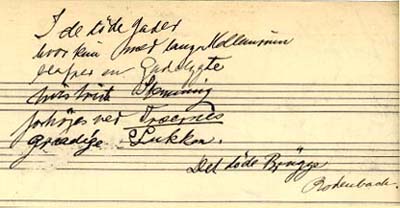The ideas behind the music
Symbolism
Symbolism was a Neo-Romantic movement that established itself in French poetry around 1890 as a reaction to naturalism and realism (Verlaine, Rimbaud, Mallarmé). The movement had an influence on Danish literature and art, and was first disseminated through the journal, Taarnet, edited by the poet, Johanens Jørgensen, and published in 1893-94.
The symbolists sought the metaphysical behind everyday reality, whatever was exalted and full of presentiment. "The artist grasps intuitively the true nature of existence. He feels the deep accord between his soul and the soul of Nature, and glimpses behind the apparent indifference of things a secret world, of which his spirit is an eternal citizen... Reality becomes for him simply the symbol of a higher world", wrote Taarnet.
Symbolism meant acceptance of whatever was individual, irrational, full of suggestive moods and feelings. The Idea was the higher form behind all things.
Langgaard may have been indirectly influenced by symbolism in his childhood and youth, and many of its ideas are to be found in his father's philosophy. Langgaard was not a declared symbolist, but the 'values' of symbolism irradiate his imaginative world, as expressed in his notes, the titles of his works and their mottoes.

Among the few direct connection between symbolism and Langgaard's music is the use he made of Georges Rodenbach's novel, Bruges-la-morte (1892), which was published in Danish in 1912 under the title Det døde Brügge (and again in 1996 as Brügge-den-døde). This novel forms the background of the piano piece, Le Béguinage (1948-49), and of Symphony No. 15, in which Langgaard depicts Ribe as "Denmark's Brügge". The motto reproduced above is based on quotations from the novel, and is the heading for the organ work, Øde Gader (Deserted Streets) (1949).
Eric Korngold's opera, Die Tote Stadt, is based on Rodenbach's novel, and Langgaard may have seen it, or heard about it, during his travels in Europe in 1921, when it was performed in several places.
Painting and sculpture inspired by symbolism were never popular in Denmark - most of the artists have been forgotten, and others changed their style. However, several of them continued to produce works of art based on symbolist ideas well into the 20th century, including J.F. Willumsen (1863-1958), and the sculptor, Rudolf Tegner (1873-1950).
Only in recent years has the importance of this trend in art been clarified and explained, not least in Henrik Wivel's monograph on art, Den store Stil. Dansk symbolisme og impressionisme omkring 1900 (1995) (The Grand Style. Symbolism and Impressionism in Denmark around 1900). In the movement in the history of ideas revealed here, among painters and sculptors, Langgaard finds a natural place which cannot be found in the context of Danish music history.
![]()
![]()

